Welcome to our guide on proper storage for fly reels! As an angler, you know how important it is to take care of your equipment to ensure its longevity and optimal performance. When it comes to fly reels, proper storage is key. By following these best practices, you can keep your fly reels in top condition and ready for your next fishing adventure.
Key Takeaways:
- Proper storage is essential for prolonging the lifespan of fly reels and maintaining their peak performance.
- Improper storage can lead to irreversible damage, including wear, reduced functionality, and debris accumulation.
- Preventative maintenance during fishing sessions, such as rinsing the reel and removing debris, is crucial for reel care.
- Performing a functional diagnostic and inspection after fishing helps identify any issues or signs of damage.
- After fishing, an at-home rinse using low-pressure water and proper drying techniques are necessary for fly reels.
Now, let’s dive into the details of why proper storage is crucial for fly reels.
Why Proper Storage is Important for Fly Reels
Proper storage plays a crucial role in maintaining the longevity and performance of fly reels. By taking the necessary precautions to store your fly reels correctly, you can prevent damage and ensure they remain in excellent condition for years to come.
Improper storage can result in irreversible damage to your fly reels. When reels are not stored properly, sand, dirt, and debris can find their way into the reel mechanism, causing wear and reducing functionality. Over time, this can lead to expensive repairs or even the need for a replacement reel.
By storing your fly reels in a safe and protective manner, you can prevent these issues and extend their lifespan. Here are a few key reasons why proper storage is essential:
- Preventing Damage: Storing fly reels appropriately helps prevent physical damage caused by external factors such as impact, moisture, and extreme temperatures.
- Protecting Against Corrosion: When fly reels are exposed to moisture for extended periods, they become susceptible to corrosion. Proper storage ensures that reels remain dry and corrosion-free.
- Maintaining Performance: By storing fly reels correctly, you can preserve their precise internal mechanisms, ensuring smooth casting, retrieving, and drag operation.
Proper storage techniques include detaching the lined spool from the frame and storing it in a sleeve or on a soft cloth to avoid unnecessary pressure or deformation. It’s also essential to store fly reels in a dry, well-ventilated area away from direct sunlight to prevent heat and UV damage.
To provide a visual representation of the proper storage methods, take a look at the table below:
| Storage Method | Pros | Cons |
|---|---|---|
| Storing in a reel case | – Offers excellent protection – Separate compartments for specific reels |
– Bulky for transportation – Additional expense |
| Hanging on a hook | – Easy access – No risk of pressure on the reel |
– Limited protection against dust or accidental falls |
| Storing in a fly tying box | – Compact storage solution – Protection against dust and debris |
– Limited ventilation – Risk of tangling with other items |
Remember, proper storage is key to fly reel maintenance and preventing damage. By implementing these storage practices, you can ensure that your fly reels stay in optimal condition, ready for your next fishing adventure.
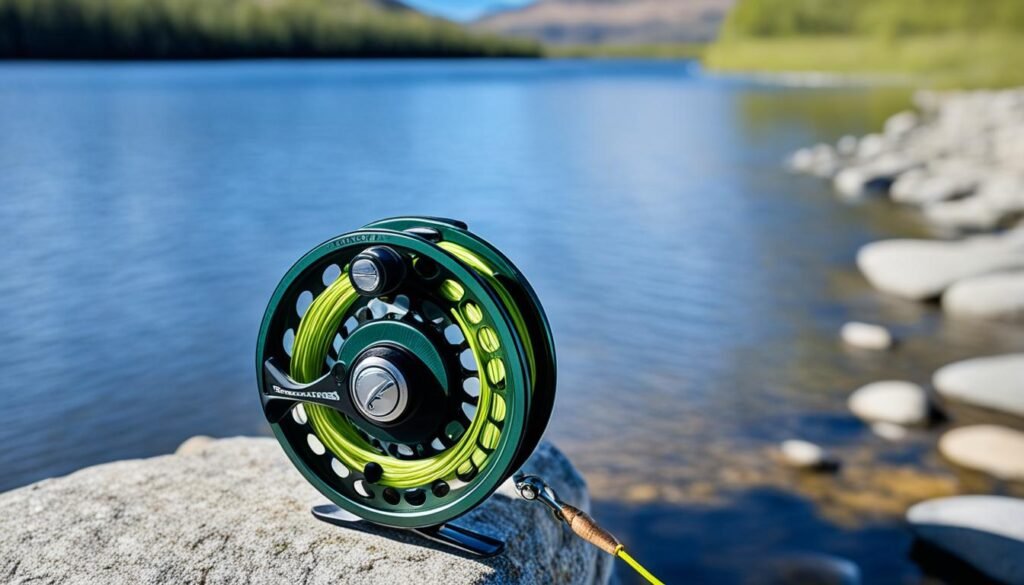
Preventative Maintenance During Fishing Sessions
During your fishing sessions, taking proactive steps to maintain your fly reel is crucial for its longevity and optimal performance. Implementing preventative maintenance measures, such as regularly rinsing the reel and removing debris, can help prevent wear and damage, ensuring your reel remains in excellent condition. A simple on-stream rinse after setting down your reel on the bank or in shallow water can go a long way in safeguarding its functionality.
When you’re out on the water, remember to take a moment to inspect your reel for any buildup of dirt, sand, or other contaminants. Using clean water from the stream or river, gently rinse the reel, paying close attention to the exterior and any crevices where debris may accumulate. This on-stream rinse will help remove foreign particles that can cause damage to the reel’s moving parts.
Regularly performing preventive maintenance, including the on-stream rinse, not only preserves the integrity of your fly reel but also extends its lifespan. By proactively protecting your reel during fishing sessions, you can enjoy smoother casting and retrieve, keeping your focus on the joys of fly fishing.
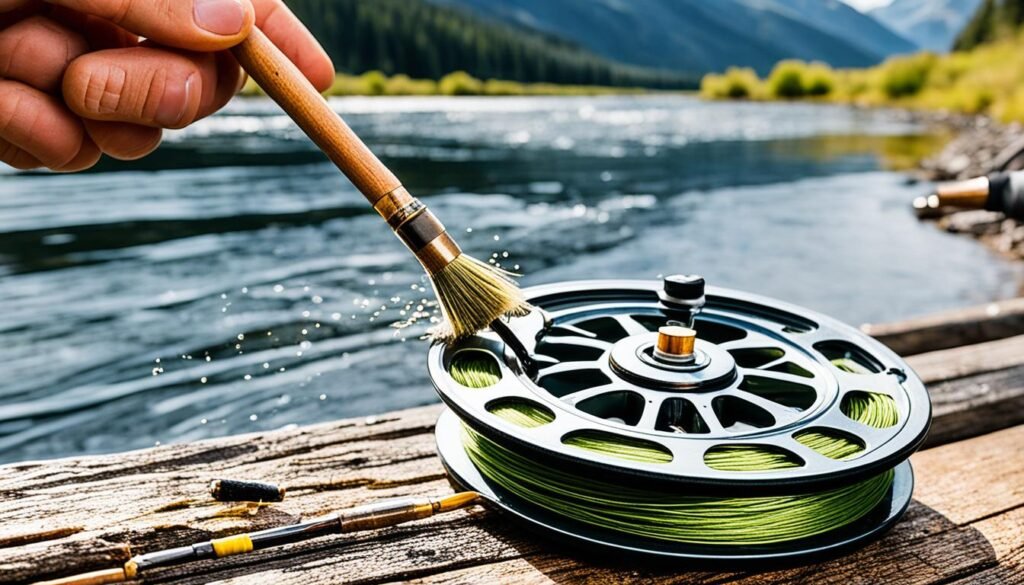
Take a look at the following table for a quick overview of the steps involved in preventative maintenance during fishing sessions:
| Preventative Maintenance Steps | Description |
|---|---|
| Rinse the reel | Use clean water to rinse off dirt, sand, and debris from the reel’s exterior and crevices. |
| Inspect for damage | Check for any visible signs of wear or damage, such as dents or scratches on the reel frame. |
| Lubricate moving parts | Apply a suitable fly reel lubricant to ensure smooth operation of the reel’s mechanisms. |
Remember, preventative maintenance is an essential part of fly reel care, helping to keep your reel in optimal condition and ready for your next fishing adventure.
Functional Diagnostic and Inspection After Fishing
After a refreshing fishing session, it is essential to give your fly reel a thorough functional diagnostic and inspection to ensure its optimal performance. This process involves checking for any signs of damage, diagnosing potential issues, and addressing them promptly to prevent further complications. By following these steps, you can extend the lifespan of your fly reel and enjoy many successful fishing trips to come.
Inspecting the Reel
Start by winding the reel with the line and leader to get a sense of its smoothness and overall functionality. Pay attention to any grinding sounds or sensations, which could indicate internal damage or debris. Additionally, check for stickiness or stiffness during reel operation, as this may affect the reel’s ability to smoothly release and retrieve line.
While inspecting the reel, be sure to examine all parts for visible damage. Look for any signs of a bent spindle, spool, or frame, as these can impact the reel’s performance and compromise its structural integrity. Take note of any scratches, dents, or corrosion, as these may lead to further damage if not addressed.
Diagnosing Reel Issues
If you notice any irregularities during the functional diagnostic, it is crucial to diagnose the root cause of the problem. Consider potential issues such as worn or damaged bearings, faulty drag systems, or misaligned gears. Identifying the specific problem will help you determine the appropriate course of action for repair or maintenance.
If you are unsure about diagnosing reel issues or lack the necessary tools and expertise, it is advisable to consult a professional fly reel technician. They have the necessary knowledge and experience to accurately assess and diagnose reel problems, ensuring the most effective solutions are implemented.
Preventive Measures
To minimize the risk of reel damage and extend its lifespan, it is important to take preventive measures. Regularly cleaning and lubricating the reel, as well as following proper storage practices, can help prevent issues that may arise from corrosion, debris, or other damaging elements.
By inspecting your fly reel and diagnosing any issues promptly, you can ensure it remains in tip-top condition for your next fishing adventure. Taking the time to care for your reel today will pay off with reliable performance and years of fishing enjoyment.
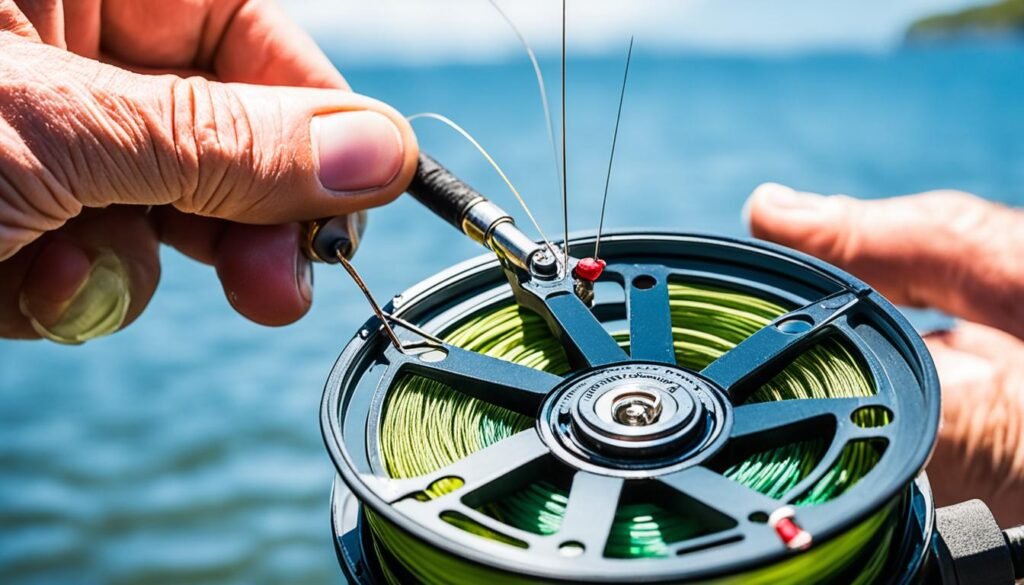
| Signs of Reel Damage | Possible Reel Issues | Suggested Actions |
|---|---|---|
| Grinding sounds or sensations | Internal damage or debris | Remove spool and clean or consult professional |
| Stickiness or stiffness during operation | Lack of lubrication or misalignment | Clean and lubricate reel or consult professional |
| Visible damage (e.g., scratches, dents, corrosion) | Structural integrity compromise | Inspect for any alignment issues or consult professional |
At-Home Rinse for Fly Reels
After a rewarding day of fishing, it’s crucial to give your fly reels the care they deserve. Performing an at-home rinse is an essential step in preserving the longevity and performance of your equipment. Here’s a step-by-step guide on how to properly rinse your fly reels:
- Step 1: Remove the lined spool
Gently remove the lined spool from the reel frame. This will allow you to thoroughly clean both the frame and the spool, ensuring no dirt or debris is left behind.
- Step 2: Rinse the reel frame
Using cool, low-pressure water, carefully rinse the entire reel frame inside and out. Be sure to pay special attention to any hard-to-reach areas, as dirt and saltwater residue can accumulate there.
- Step 3: Wipe away dirt and debris
Take a clean cloth and gently wipe away any remaining dirt and debris from the reel frame. Removing these particles will prevent them from causing damage and ensure smooth operation during your next fishing trip.
- Step 4: Shake off excess water
Give the reel frame a gentle shake to remove any excess water. This will help prevent water spots and corrosion, keeping your fly reel in excellent condition.
Following these simple steps after each fishing session will help extend the lifespan of your fly reel and maintain optimal performance for future outings.
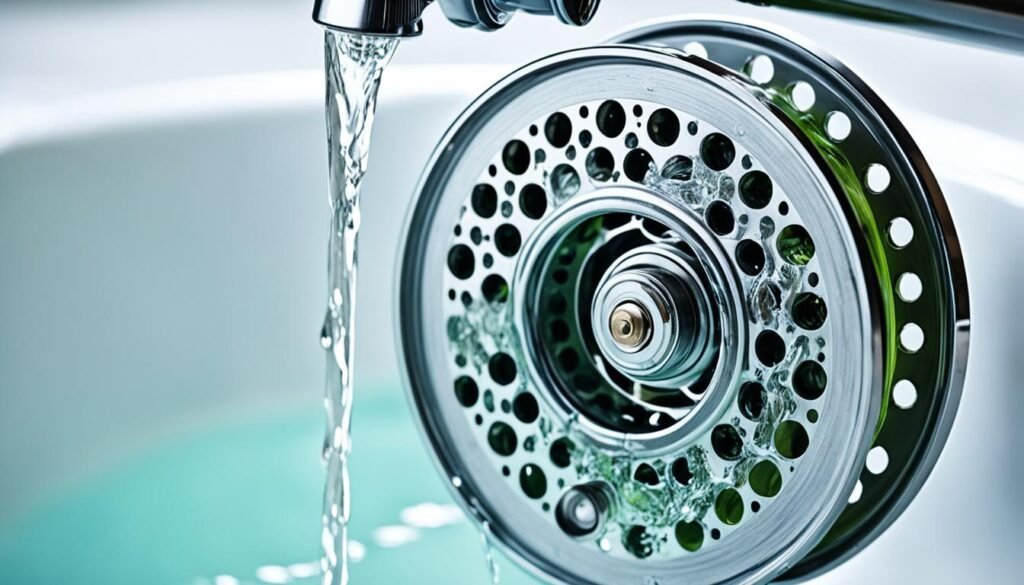
| Benefits of At-Home Rinse for Fly Reels | Cleaning Frequency |
|---|---|
| Cleans dirt and saltwater residue | After every fishing session |
| Prevents corrosion and damage | After every fishing session |
| Ensures smooth operation | After every fishing session |
Proper Drying Techniques for Fly Reels
After rinsing, it’s crucial to properly dry fly reels before storing them. This ensures that moisture doesn’t build up and cause damage over time. Here are some effective drying techniques to follow:
Air-Drying Fly Reels
The most recommended method for drying fly reels is air-drying. After rinsing off any debris or residue, simply set the reels aside in a dry and well-ventilated area. This allows the reels to naturally air-dry without the need for excessive heat or moisture. Make sure to keep the reels away from direct sunlight to avoid damage to the PVC surfaces of lines and reel finishes.
Pro Tip:
Avoid using heat sources like hair dryers or heaters to speed up the drying process, as these can potentially damage the reel components.
By patiently allowing the fly reels to air-dry, you can ensure that all moisture evaporates, minimizing the risk of any long-term damage.
Preventing Moisture Buildup
To avoid moisture buildup during the drying process, make sure the reels are completely dry before storing them. This prevents the growth of mold and rust, which can impair the performance and lifespan of the reel. Before storing, double-check that there is no dampness or residue on the reel’s surface.
Remember to remove the lined spool from the reel frame for more effective drying. This ensures that all parts of the reel, including the inner mechanisms, are thoroughly dried.
Here’s an example of an effective fly reel drying technique:
| Drying Technique | Description |
|---|---|
| Air-Drying | Set the reel aside in a dry and well-ventilated area to air-dry. Avoid direct sunlight to prevent damage. |
By following these proper drying techniques, you can maintain the quality and performance of your fly reels, ensuring they last for many successful fishing trips to come.
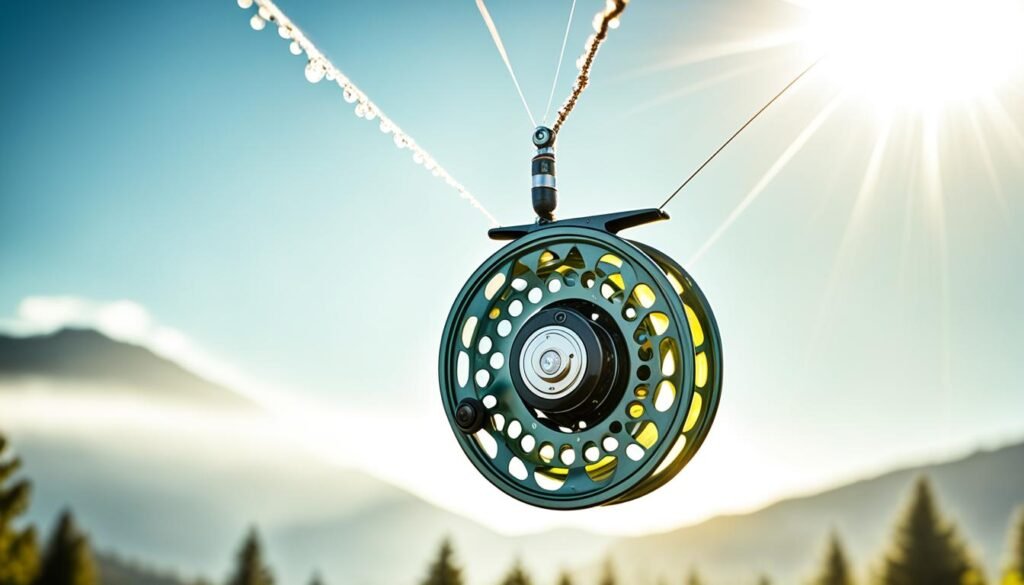
Storing Fly Reels to Prolong Lifespan
Proper storage is crucial for maintaining the longevity of your fly reels and protecting them from unnecessary damage. By following the right storage methods, you can ensure your fly reels stay in optimal condition and ready for your next fishing adventure.
When it comes to storing fly reels, one of the key considerations is finding a suitable location. Look for a safe shelf, table top, or workbench away from direct sunlight. Prolonged exposure to sunlight can cause the reel’s finish to fade and degrade over time, impacting its performance.
To further safeguard your fly reel during storage, it’s important to detach the lined spool from the frame. This helps prevent any unnecessary strain or pressure on the reel components. Consider using a protective sleeve or soft cloth to store the lined spool separately, keeping it safe from potential scratches or other damage.
Avoid storing your fly reels in damp or humid environments. Moisture can lead to corrosion or rust, which can significantly affect the reel’s functionality. If possible, choose a storage area with low humidity and good ventilation to prevent any moisture-related issues.
By taking the time to store your fly reels properly, you can prolong their lifespan and ensure they remain in excellent condition. Now, let’s take a look at some fly reel storage solutions that can provide additional protection and convenience.
Be mindful of the impact of storage conditions on your fly reels. Choose a suitable location, detach the lined spool, and avoid damp or humid environments to protect your reels during storage.
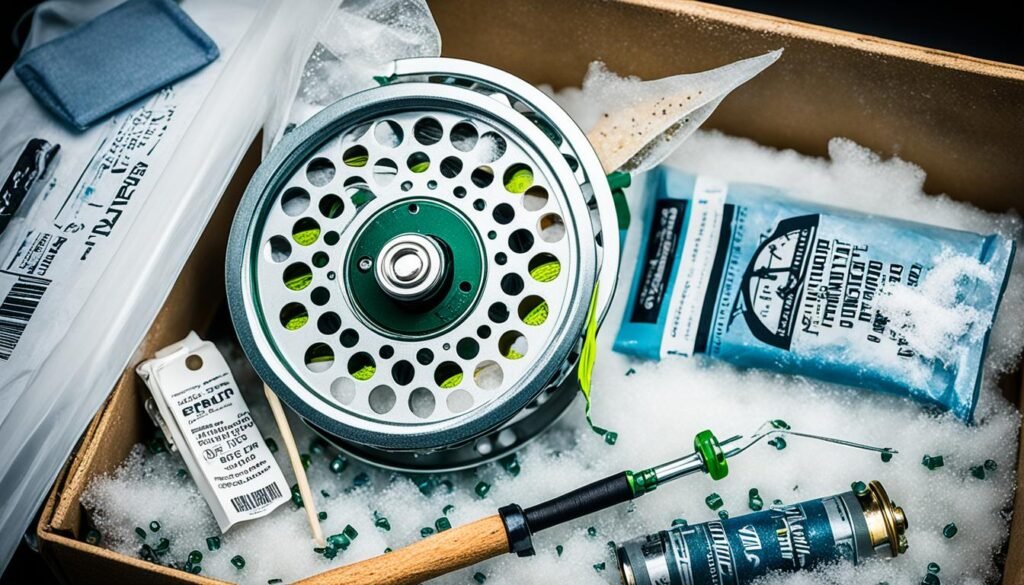
Fly Reel Storage Solutions
If you’re looking for ways to enhance your fly reel storage setup, consider these fly reel storage solutions:
| Storage Solution | Description |
|---|---|
| Rod Tubes | Use rod tubes with built-in compartments to store your fly reels securely. This keeps them organized and protected from potential damage. |
| Reel Cases/Pouches | Invest in reel cases or pouches specifically designed for fly reels. These provide cushioning and prevent scratches during storage and transportation. |
| Reel Cabinets | For anglers with an extensive reel collection, reel cabinets offer an organized and visually appealing storage solution. These cabinets often include individual compartments to protect each reel. |
| Rod and Reel Racks | A rod and reel rack is a practical option for storing multiple fly rods and reels in one place. These racks often feature adjustable holders to accommodate different reel sizes. |
Explore these storage solutions to find the one that best suits your needs and helps protect your fly reels during storage.
Cleaning and Conditioning Fly Lines
Properly cleaning and conditioning fly lines is crucial for preserving their performance and extending their lifespan. Regular maintenance will ensure that your fly lines remain in optimal condition, allowing for smooth casts and precise presentations. Follow these steps to keep your fly lines clean and well-maintained.
Clean Your Fly Lines Regularly
To remove dirt, grime, and debris from your fly lines, clean them regularly using warm water and mild soap. Fill a basin or sink with warm water and add a small amount of mild soap.
- Gently submerge the fly line in the soapy water and agitate it with your hands, being careful not to tangle or damage the line.
- Use a soft cloth or sponge to wipe the entire length of the line, paying special attention to any areas with visible dirt or stains.
- Rinse the line thoroughly with clean water to remove any soap residue.
- Pat the line dry with a clean cloth or allow it to air dry before using or storing.
Condition Your Fly Lines
In addition to cleaning, conditioning your fly lines is essential for preserving their performance and ensuring their slickness. Fly line dressing helps restore the line’s smoothness and improves its ability to shoot through the guides during casts.
Pro Tip: Avoid using silicone-based products for fly line dressing, as they can cause the line to become too slick, leading to overspooled or tangled casts.
Apply a specialized fly line dressing to your cleaned and dry fly line by following these steps:
- Apply a few drops of fly line dressing onto a clean cloth or sponge.
- Hold the fly line and run it through the cloth or sponge, applying light pressure to evenly distribute the dressing on the entire length of the line.
- Allow the dressing to dry for the recommended time specified by the manufacturer.
- After the dressing has dried, wipe off any excess with a clean cloth.
Avoid Stripping Lines Across the Reel Post
When handling and storing your fly line, avoid stripping it across the post of the reel. This repetitive motion can cause abrasion and wear on the line, leading to decreased performance and potential line damage. Instead, use your hands to guide the line during stripping or utilize line management tools, such as line stripping baskets or pads, to prevent unnecessary friction and protect your fly line.

By following these cleaning and conditioning practices, you can preserve the performance of your fly lines and enjoy optimal casting and fishing experiences. Regular maintenance will help extend the lifespan of your fly lines, ensuring that they remain in excellent condition for many fishing seasons to come.
Storing Fly Lines
Properly storing fly lines is essential for maintaining their longevity and ensuring optimal performance. By following these tips, you can keep your fly lines in excellent condition for many fishing seasons to come.
Coiling Fly Lines
When storing fly lines, it’s important to coil them in loose loops to prevent kinks and twists. This ensures that the lines remain tangle-free and ready for use. Avoid tightly coiling the lines as this can cause memory and affect their casting performance.
To secure the coils, you can use pipe cleaners or elastic bands. Wrap them around the coiled lines to hold them in place. This provides added convenience when it comes time to retrieve the lines for your next fishing adventure.
Organizing Fly Lines
To keep your fly lines organized and easily accessible, it’s a good idea to store them in a resealable plastic bag. This not only protects the lines from dirt, dust, and moisture but also helps to prevent any tangling or damage during storage.
When sealing the bag, be sure to label it with relevant information such as the line weight, type, and any special characteristics. This makes it easier to identify the specific line you need without having to open every bag.
Avoiding Sun Exposure
Extended exposure to sunlight can be detrimental to the performance and lifespan of fly lines. UV rays can degrade the outer coating of the lines, causing them to become brittle and lose their slickness.
Store your coiled fly lines in a cool, dry place away from direct sunlight. This helps to preserve their integrity and ensures that they maintain their casting performance over time.

Conclusion
Proper storage practices are crucial for ensuring the longevity and peak performance of your fly reels. By implementing best practices for fly reel care and storage, you can protect your equipment and enhance your fly fishing experience for years to come.
First and foremost, practicing preventative maintenance during fishing sessions is essential. Take the time to rinse your reel and remove any debris after setting it down on the bank or in shallow water. This simple step can prevent wear and damage to your fly reel, extending its lifespan.
After each fishing session, perform a thorough inspection of your fly reel. Check for any grinding sounds or sensations, stickiness, or abnormalities in the reel’s functionality. Additionally, inspect all parts for visible damage, such as a bent spindle, spool, or frame. Identifying and addressing any issues promptly will help prevent further damage.
Once you’ve returned home, give your fly reel a proper cleaning. Rinse the reel frame with cool, low-pressure water to remove any dirt and debris. Use a clean cloth to wipe away any remaining residue and shake off excess water. Allow the reel to air dry in a dry and well-ventilated area, ensuring it is completely dry before storing.
To store your fly reel, choose a safe location away from direct sunlight. Detach the lined spool from the frame and store it in a sleeve or on a soft cloth to protect it from scratches and dings. Avoid storing your reel in damp or humid environments, as moisture can cause damage.
By following these proper storage practices, along with regular cleaning and maintenance, you can ensure that your fly reels remain in optimal condition. Taking care of your equipment will not only extend its lifespan but also enhance your overall fly fishing experience.
FAQ
Why is proper storage important for fly reels?
Proper storage is essential for prolonging the lifespan and ensuring the peak performance of fly reels. It helps protect them from damage and keeps them in top working order.
What are some preventative maintenance measures to take during fishing sessions?
During fishing sessions, it’s important to rinse the reel and remove debris after setting it down on the bank or in shallow water. Regularly performing an on-stream rinse can help prevent wear and damage to the reel.
What should be done for a functional diagnostic and inspection after fishing?
After a fishing session, wind the reel with the line and leader to check for any grinding sounds or sensations, stickiness or stiffness, or abrupt starting and stopping. Inspect all parts for visible damage and signs of a bent spindle, spool, or frame.
How should I perform an at-home rinse for fly reels?
After returning home from fishing, remove the lined spool from the reel frame and rinse the entire frame inside and out with cool, low-pressure water. Use a clean cloth to wipe away dirt and debris from the frame and shake off any excess water.
What are proper drying techniques for fly reels?
After rinsing, it’s crucial to properly dry fly reels before storing them. Set the reels aside in a dry and well-ventilated area to air-dry. Avoid direct sunlight, as UV rays can damage the PVC surfaces of lines and reel finishes. Allow reels to dry completely before storing to prevent moisture buildup.
How should fly reels be stored to prolong their lifespan?
Choose a safe shelf, tabletop, or workbench out of direct sunlight to store the reel. Detach the lined spool from the frame and store it in a sleeve or on a soft cloth. Avoid storing reels in damp or humid environments, as moisture can cause damage.
How should fly lines be cleaned and conditioned?
Properly cleaning and conditioning fly lines is important for maintaining their performance. Clean fly lines regularly with warm water and mild soap, and use a proper fly line dressing to restore their slickness. Avoid stripping lines across the post of the reel to prevent abrasion.
How should fly lines be stored?
Coil cleaned fly lines in loose loops and secure them with pipe cleaners. Store the coiled lines in a resealable plastic bag, labeled with relevant information. Avoid extended sun exposure and keep lines stored in a cool, dry place.
Why is proper storage important for fly reels?
Proper storage practices are crucial for fly reels to ensure their longevity and peak performance. By following these best practices, including preventative maintenance, cleaning and conditioning, and proper storage techniques, you can protect your fly reels and enjoy them for many seasons to come.

